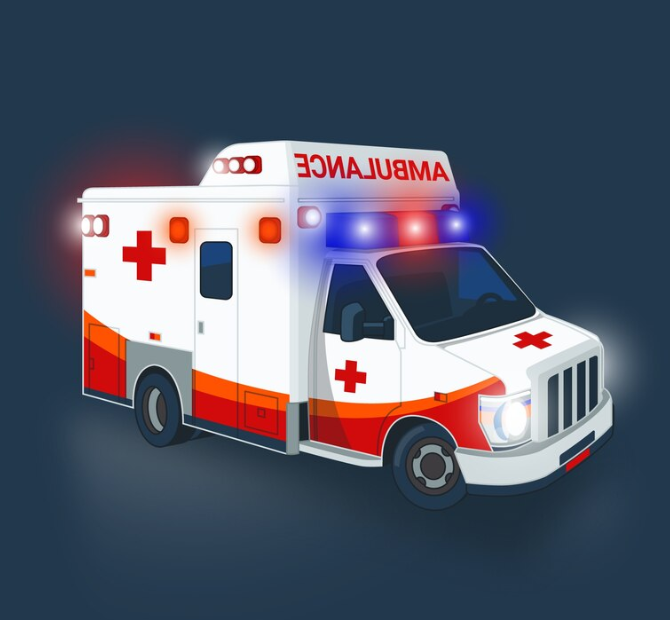The role of an Ambulance Service is critical in delivering timely and effective medical care during emergencies. A 24 Hours Ambulance Service, operating round-the-clock, must be equipped to handle diverse medical situations promptly. One of the most frequent questions posed by patients and their families is whether ambulances in such services are outfitted with advanced medical tools to ensure life-saving interventions. This article delves into the essential features, benefits, and components of ambulances in a 24 Hours Ambulance Service, emphasizing their advanced equipment and capabilities.
Understanding a 24 Hours Ambulance Service
A 24 Hours Ambulance Service is designed to provide uninterrupted emergency care and medical transport. Unlike regular ambulance services, which may operate only during specific hours, these services are available at any time of the day or night. They cater to a wide range of emergencies, including:
- Cardiac arrests
- Accidents and trauma cases
- Respiratory distress
- Maternity emergencies
- Transfers between medical facilities
Such services are supported by trained paramedics, EMTs (Emergency Medical Technicians), and state-of-the-art medical tools to ensure that patients receive comprehensive care during transport.
Types of Ambulances in a 24 Hours Ambulance Service
Ambulances in a 24 Hours Ambulance Service are categorized based on their functionality and the medical equipment they carry. These categories include:
1. Basic Life Support (BLS) Ambulances
BLS ambulances cater to patients requiring non-critical medical transportation. While these ambulances are not heavily equipped, they include:
- Stretchers and wheelchairs
- Oxygen cylinders
- Basic first-aid kits
- Automated External Defibrillators (AEDs)
2. Advanced Life Support (ALS) Ambulances
ALS ambulances handle critical emergencies and are equipped with advanced medical tools such as:
- Cardiac monitors and ventilators
- Infusion pumps
- Portable defibrillators
- Advanced airway management devices
3. Critical Care Ambulances (CCAs)
Critical care ambulances are mobile ICUs. They cater to patients requiring intensive care during transport. Equipment includes:
- Invasive monitoring systems
- Blood analyzers
- Emergency surgical kits
Key Advanced Medical Tools in a 24 Hours Ambulance Service
The ability of an ambulance to provide timely, high-quality care often depends on its equipment. Here is an overview of advanced tools commonly found in ambulances associated with a 24 Hours Ambulance Service:
1. Cardiac Monitors
Cardiac monitors are essential for tracking a patient’s heart activity. They provide real-time data to paramedics and help in detecting irregularities such as arrhythmias or cardiac arrests.
2. Ventilators
For patients struggling with respiratory issues, ventilators are life-saving. These devices ensure proper oxygen delivery, which is vital during emergencies like asthma attacks, pneumonia, or COVID-19 complications.
3. Defibrillators
Defibrillators are indispensable in reviving patients experiencing sudden cardiac arrests. Automated External Defibrillators (AEDs) are commonly used in Ambulance Services for immediate response.
4. Portable Suction Devices
Suction devices clear the airway of obstructions like blood, vomit, or mucus, allowing paramedics to stabilize the patient’s breathing.
5. Infusion Pumps
These devices control the precise delivery of fluids, medications, or nutrients, crucial in treating dehydration, infections, or managing drug therapies during transport.
6. Pulse Oximeters
Pulse oximeters measure oxygen saturation levels, providing critical information about a patient’s respiratory health during transit.
Why Advanced Medical Tools Matter in a 24 Hours Ambulance Service
The presence of advanced medical tools in ambulances significantly enhances the efficiency and outcomes of emergency responses. Key benefits include:
1. Faster Stabilization of Patients
With tools like ventilators and defibrillators, paramedics can stabilize patients effectively before they reach the hospital.
2. Increased Survival Rates
Immediate access to cardiac monitors and infusion pumps ensures timely interventions, often increasing the chances of survival.
3. Comprehensive On-Scene Care
Advanced equipment enables paramedics to provide nearly hospital-grade care at the scene of the emergency or during transportation.
4. Seamless Communication with Hospitals
Tools like cardiac monitors with data-sharing capabilities allow paramedics to send patient information to hospitals in real-time, ensuring seamless handovers.
Training and Expertise: The Human Factor
While advanced tools are crucial, the efficacy of a 24 Hours Ambulance Service also depends on the training and expertise of its personnel. EMTs and paramedics undergo rigorous training to:
- Operate advanced medical tools effectively
- Perform life-saving procedures like CPR, intubation, and administering medications
- Manage high-pressure situations with professionalism
Common Challenges and Misconceptions
1. Are All Ambulances Fully Equipped?
Not all ambulances carry the same level of equipment. While BLS ambulances handle non-critical cases, ALS and critical care ambulances are equipped with advanced tools.
2. Is Advanced Equipment Always Necessary?
For minor injuries or non-urgent transport, basic ambulances suffice. However, in critical emergencies, the availability of advanced tools can be the difference between life and death.
The Role of Technology in Enhancing Ambulance Services
Modern advancements are continually improving 24 Hours Ambulance Services. Innovations such as telemedicine integration and GPS tracking ensure:
- Faster response times
- Enhanced patient monitoring
- Better coordination with hospitals
Choosing a Reliable 24 Hours Ambulance Service
When selecting an Ambulance Service, ensure they offer:
- A variety of ambulances tailored to different medical needs
- Well-trained staff capable of using advanced equipment
- Round-the-clock availability with quick response times
Future Trends in Ambulance Services
The future of Ambulance Services lies in adopting cutting-edge technologies such as AI-driven diagnostics, autonomous ambulances, and portable diagnostic labs, ensuring better preparedness and efficiency in emergency care.
Conclusion
A 24 Hours Ambulance Service equipped with advanced medical tools plays a pivotal role in emergency healthcare. While not all ambulances carry the same level of equipment, services offering ALS and critical care units ensure top-tier medical care during transit. These tools, coupled with skilled personnel, bridge the gap between the site of the emergency and the hospital, saving countless lives. Whether you are considering emergency support for personal needs or evaluating services in your area, understanding the capabilities of these ambulances ensures better preparedness in times of need.
